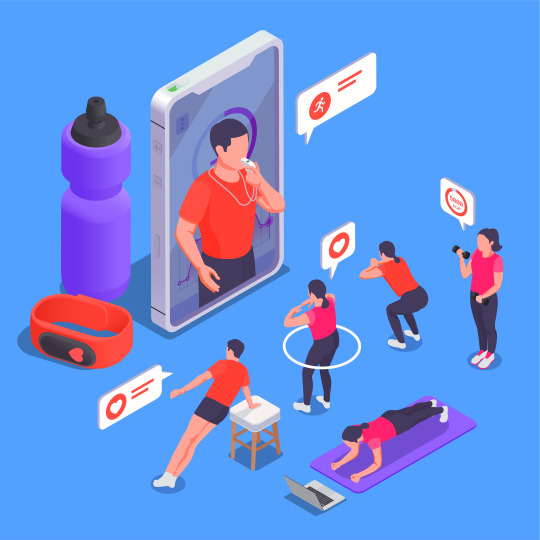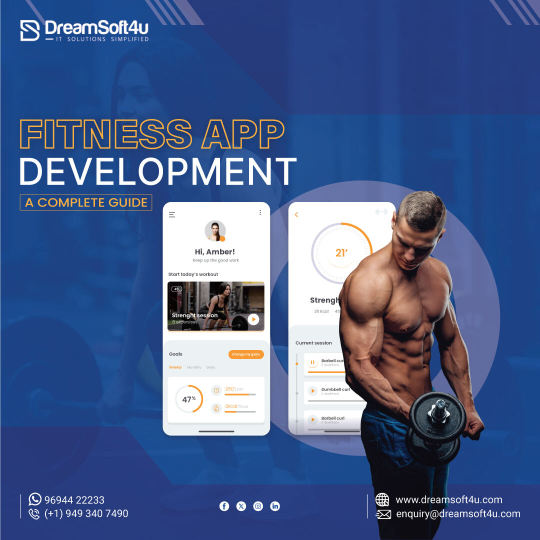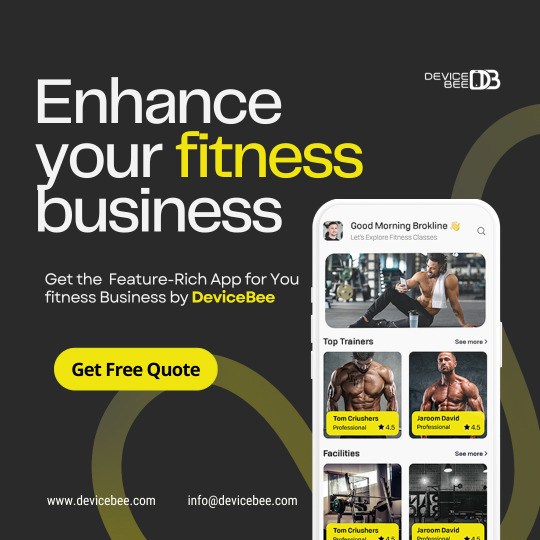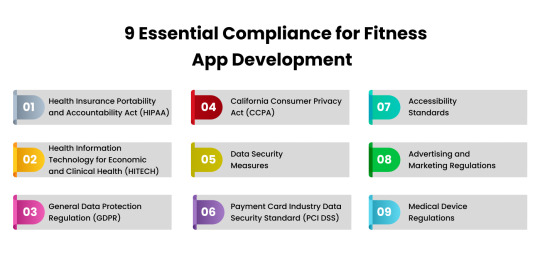#Fitness App Development
Explore tagged Tumblr posts
Photo

(via 5 Best Fitness App Development Companies in USA - Networkblogworld.com)
2 notes
·
View notes
Text
Below you can see what has been recognised as the best fitness app development companies that advance the industry and provide efficient fitness apps.
1 note
·
View note
Text
Innovative Fitness App Development to Help Your Business Grow
Innovative Fitness App Development to Help Your Business Grow

In today’s fast-paced world, the fitness industry is rapidly evolving, and mobile apps are playing a crucial role in this transformation. Whether you're a fitness coach, gym owner, or health enthusiast, having a custom fitness app is more than just a trend—it's a strategic business decision. Innovative fitness app development can help you grow your business by offering users personalized experiences, increasing engagement, and providing a platform for your services to reach a wider audience.
Why Fitness App Development is Essential for Your Business
1. Growing Demand for Fitness Solutions
With more people becoming health-conscious, the demand for fitness apps has skyrocketed. Consumers now prefer to have their fitness routines, nutrition plans, and health tracking right at their fingertips. As a business, having a fitness app provides an excellent opportunity to tap into this growing demand and provide your users with a seamless experience.
2. Personalized Experience
One of the biggest advantages of custom fitness app development is the ability to offer personalized experiences to users. From workout plans tailored to their fitness levels to nutrition recommendations based on their goals, a personalized approach helps retain customers and increase user satisfaction. It’s this level of customization that sets your fitness app apart from generic apps available in the market.
3. Increased Customer Engagement
An engaging and well-designed fitness app can help you keep your customers motivated and involved with your services. Features such as push notifications, progress tracking, virtual training, and social sharing options can encourage users to remain active and engaged with their fitness goals. This continuous engagement not only enhances the user experience but also builds long-term loyalty to your brand.
4. Expand Your Reach
Fitness app development opens up new opportunities to expand your reach beyond your local market. By offering digital fitness services, you can attract users from all over the world. Whether you're a gym offering virtual classes or a personal trainer providing one-on-one coaching, a fitness app can bring your services to a broader audience and allow you to scale your business.
Key Features to Include in a Fitness App
For a fitness app to stand out and deliver value to its users, it needs to have certain essential features. Here’s a breakdown of the key features you should consider integrating into your fitness app:
1. Customizable Workout Plans
Allow users to create or choose workout plans based on their fitness levels, goals, and preferences. This personalization encourages users to stick to their fitness regimen and boosts app retention rates.
2. Progress Tracking
Fitness is all about progress, and an app should be able to track user progress accurately. Include features for tracking calories burned, steps taken, workout durations, weight loss, and more. This helps users see their improvements and stay motivated.
3. Nutrition Tracking
Integrate a nutrition tracker that helps users monitor their diet, providing them with data on calorie intake, macronutrients, and hydration levels. This feature ensures that users stay on track with their fitness goals and make healthier food choices.
4. Virtual Coaching and Classes
Including live classes, virtual coaching, or pre-recorded sessions can add immense value to your app. Whether it’s yoga, pilates, HIIT, or strength training, offering a variety of virtual fitness classes will attract a wide user base.
5. Social Integration
Fitness is often a social experience, and integrating social features such as community forums, social sharing options, or progress leaderboards can foster a sense of community. Users can share their achievements, challenge others, and inspire each other to achieve their goals.
6. Gamification
Gamification is a powerful tool in the fitness app world. By incorporating challenges, badges, rewards, and leaderboards, you can motivate users to stay consistent and challenge themselves to improve their fitness levels.
The Process of Fitness App Development
Developing a fitness app involves several critical stages. Here’s a quick overview of the typical process:
1. Idea and Research
The first step is to define the core concept of your app. Conduct market research to understand the needs of your target audience and identify what features will set your app apart from the competition.
2. Planning & Design
Once the idea is defined, the next step is to plan the app's functionality and design. A user-friendly interface and seamless experience are essential in keeping users engaged. Focus on easy navigation, appealing visuals, and smooth transitions.
3. Development
After planning, it’s time for the development phase. Choose the right platform (iOS or Android) and technology stack for your app. At this stage, you’ll integrate the features and functionalities that will provide value to your users.
4. Testing & Quality Assurance
Before launching your app, thorough testing is essential to ensure its functionality, usability, and performance. A fitness app should work seamlessly, and bug-free apps offer a better user experience.
5. Launch and Marketing
Once your app is ready, it’s time to launch it on platforms like the App Store or Google Play. Along with the launch, a strong marketing strategy will help generate interest in your app and attract users.
6. Ongoing Updates & Maintenance
After the launch, continuous updates are necessary to keep your app relevant and improve user experience. Address user feedback, introduce new features, and fix any issues that arise post-launch.
How Telepathy Infotech Can Help with Fitness App Development
At Telepathy Infotech, we specialize in developing custom fitness apps that meet the unique needs of our clients. Our team of experienced developers and designers will work closely with you to create a fitness app that reflects your brand’s identity and delivers an exceptional user experience. Whether you want to offer personalized workout plans, virtual coaching, or progress tracking, we can help bring your vision to life.
Our development process focuses on building apps that are not only feature-rich but also scalable and secure, ensuring long-term success for your business. With Telepathy Infotech, you’ll have a reliable partner who is committed to providing innovative solutions that drive user engagement and business growth.
Conclusion
Fitness app development is a powerful way to grow your business and engage with your audience in meaningful ways. With the right features, seamless functionality, and an intuitive user interface, a fitness app can enhance your brand’s reputation and help you scale globally. Whether you’re a fitness trainer, gym owner, or wellness brand, investing in a custom fitness app is an investment in the future of your business.
If you’re looking for expert fitness app development services, reach out to Telepathy Infotech today. We’ll help you create an innovative fitness app that empowers your users to achieve their fitness goals while driving business growth for you.
0 notes
Text
Our fitness and wellness app developers leverage cutting-edge technology stacks that seamlessly operate across all top-tier devices.
#Fitness App Development#appdevelopment#webdesign#androiddevelopment#webdevelopment#websitedevelopment#appdesign#developer#androidstudio#iosdevelopment#software company
0 notes
Text
0 notes
Text
AI-Enabled Fitness Apps: A New Era of Workout Experiences
Elevate your fitness game with our latest blog on "AI-Enabled Fitness Apps"! Explore how artificial intelligence is transforming health and wellness by offering personalized workout plans and real-time performance tracking. Discover innovative features, inspiring user success stories, and valuable tips for selecting the perfect app to align with your fitness goals. Whether you’re just starting out or a seasoned pro, our insights will empower you to leverage AI for optimal results. Don’t miss out—dive into the blog and kickstart your transformation today! Your future self will be grateful!
0 notes
Text
What Are The Feature Trends And Cost Of Fitness App Development?

In recent times, however, fitness applications have received high popularity, mainly because of growing health consciousness and a desire for personalized solutions. With growing awareness that building a healthy lifestyle is vital, an ever-increasing number of people demand novel applications in fitness.
In this article, new feature trends in fitness app development and the costs of developing an effective and engaging app will be explored.
Understanding the Fitness App Landscape
Fitness applications are part of most people's daily activities. These apps have different functionalities, and some can be used to track workouts or diets, provide virtual coaching, or offer community support.
This has led to some significant changes in how technology is slowly creeping into one's fitness regimens.
Rise of personal experiences.
Personalization is one of the most dominant trends in app development in the fitness sector. It reflects the desire of users for applications that will help develop and tone bodies according to personal tastes and fitness levels.
Customizable workouts: set up adaptations of the routines as per the user's fitness level and intended goal based on the availability of tools.
Adaptive learning algorithms: use machine learning to analyze user data and continually provide them with more personalized recommendations over time.
Goal Setting and Tracking: The application should guide the user to set and then track against their realistic fitness goals.
Dietary Customization: Should include meal plans specific to a variety of dieters' preferences, such as vegetarian, vegan, or even keto.
Integration of Wearable Technology
Another massive trend in design for a fitness app is with integration of wearable technology. With the development of the smartwatch and the fitness tracker, apps can follow actual real-time activities dealing with physical fitness, heart rates, sleep, and much more.
Benefits of Wearable Integration:
Real-Time Monitoring of Data: Instant workout and health metrics feedback makes the user monitor their workouts as and when required.
Increased User Engagement: Users will be motivated to exercise, and complete the fitness program effectively with the help of notifications and alerts.
Data Synchronization: In avoiding data loss or leaving out important fitness details, users can easily sync their fitness data from multiple devices while gaining experience in seamless smoothness.
Fitness Gamification
Gamification is one of the more promising trends that redefine the nature of fitness app design. Game-like features in apps make exercises fun.
Key Elements of Gamification:
Rewards and Badges: Provide rewards based on usage time period.
Leaderboards: Can create a socializing environment, where they have competition with their friends or other users in the app
Challenges and Quests: They offer time-bound challenges, encouraging the user to do as much as possible and also introduce them to new exercises.
This indicates that the community can be involved in making the creation of the world.
Community Building and Social Features
One of the central features of fitness in today's digital technology-oriented age has been community. Many users like applications that feature a community where one connects with others who have set out with the same aims for fitness.
Community features include the following.
Share on social: Users can share their achievements, workout, and progress on their social media.
Group Challenges: It is challenging for the users to collaborate in interaction toward a common goal and, at the same time, can build motivation and engagement.
In-App Messaging: It enables the user-to-user and is possibly helpful in building a supportive fitness community.
Role of AI and Virtual Coaching
Artificial intelligence in Fitness App Development has been strictly utilized today since it renders smart solutions that users require for coaching.
Benefits of AI in Fitness Apps
Virtual Personal Coaches: Offer users on-demand coaching and workout guidance through unique profiles.
Smart Feedback: Analyzes user performance, which would give real-time feedback to improve workout efficiency.
Talkbots As Support: They will be available to answer questions about workout or nutrition, or how to use an application, all 24/7.
Cost-Related Challenges with Fitness App Development
Any start-up in the fiercely competitive market of fitness apps must know about the costs associated with fitness app development. There is quite a divergence in the cost related to this depending on multiple aspects including the complexity of the app, the feature set, and the development platform.
Breakout of Development Costs
Plan and Research: One cannot throw oneself into development without much research. This development costs in the range of $5,000 to $15,000 depending on the intensive level of market analysis and feature planning .
Design: UI/UX plays an important role in user engagement. High quality engaging design improving user experience would require a cost of around $10,000 to $25,000.
Development: This all depends on just how complex the application can be. Something simple that functions by having basic functionality will cost about $20,000-$40,000, but most applications build up with more features cost upwards of $50,000 and upwards into a hundred-thousand dollars.
Testing and Quality Assurance: Your app must be free from bugs in every given aspect of the application. Budget for about $5,000-$15,000 in full testing of the application on as many devices and operating systems as possible.
Marketing: once the app is ready, some form of marketing for the app will find its way into the marketplace. $10,000-$50,000 will be needed for initial marketing attempts targeted at the consumers you created.
Cost after launch: Once launched, eternal costs are incurred in the form of maintenance and enhancements of estimates amounting to between 15-20% of development cost annually.
Cost Influencing Factors
Feature Complexity: Advanced features such as AI integration or real-time data analytics will double your investment.
Cross-platform: If you want an application for iOS and Android, all at once, your spend may double. More cross-platform solutions occur at much lower cost.
Development Team Location: Depending on location, costs vary wildly. Generally speaking, North America is more expensive, but with the option of reducing that price through Eastern Europe, India, or Asia.
Monetization Strategy: If you are implementing in-app purchase or subscriptions or ads, this impacts the pre-build costs and then the operating cost thereafter.
Conclusion
The fitness industry changes every day differently, and the fitness app development domain is certainly no exception. Monitoring what is new in terms of personalization, wearable integration, gamification, and artificial intelligence will make all the difference between applications being user-friendly and really effective.
This is very cost-intensive, with a large variation in developmental costs. But proper planning and understanding of the market will help you make better decisions whether you are an entrepreneur launching a new fitness app or a developer who wants to enhance the existing offerings. Being in touch with these trends and cost factors would be crucial in this ever-changing field.
This way, investment in fitness app development will not only provide a possible return in terms of money but promise the creation of a healthier world. Hence, it becomes worthwhile to consider.
0 notes
Text
Developing a Fitness App on a Budget: Tips and Tricks
In recent years, fitness app development has gained significant momentum as more individuals prioritize their health and fitness. A fitness app can help users track their workouts, monitor their progress, and maintain a healthy lifestyle. However, developing a fitness app on a budget requires a clear understanding of the process and the essential elements involved.
With the increasing reliance on technology, fitness apps have surged in popularity, providing users with convenient and accessible ways to stay healthy. These apps offer a range of features, from personalized workout plans to nutrition tracking, making it easier for users to achieve their fitness goals. As a result, the fitness app market has witnessed substantial growth, with more developers entering the scene to create innovative solutions.
In this blog, we will discuss what fitness app development is, the types of fitness apps, and strategies to manage fitness app development cost-effectively
What is Fitness App Development?
Fitness app development involves creating a mobile application designed to help users with their fitness goals. These apps can offer various features, such as workout routines, diet plans, progress tracking, and social sharing capabilities. The process includes ideation, designing the user interface, coding, testing, and launching the app. Collaborating with a reliable fitness app development company can ensure your app meets industry standards and user expectations.
By understanding the nuances of fitness app development, you can create a functional and appealing app that meets the needs of health-conscious users without breaking the bank. In the following sections, we'll explore tips and tricks to develop a fitness app on a budget, discuss the fitness app development cost, and highlight the importance of choosing the right fitness app development company.
Types of Fitness Apps
There are several types of fitness apps, each catering to different aspects of health and wellness:
Workout and Exercise Apps: Provide users with exercise routines, video tutorials, and personalized workout plans.
Nutrition and Diet Apps: Offer meal plans, calorie counting, and nutrition tracking.
Activity Tracking Apps: Monitor physical activities like walking, running, and cycling, often integrating with wearable devices.
Yoga and Meditation Apps: Guide users through yoga sessions and meditation practices.
Planning Your Fitness App Development on a Budget
When it comes to fitness app development, careful planning is essential to ensure you stay within budget while still delivering a high-quality product. Here are some key steps to consider when planning your fitness app development on a budget:
1. Define Your App’s Core Features
Start by identifying the core features that are essential for your fitness app. Focus on the functionalities that will provide the most value to your users. Some basic features to consider include:
User registration and profiles
Workout and exercise routines
Progress tracking
Integration with wearables
Push notifications
2. Conduct Market Research
Understanding the competitive landscape is crucial for developing a fitness app that stands out. Conduct thorough market research to identify trends, user preferences, and gaps in existing fitness apps. This information will help you make informed decisions about the features and design of your app, ensuring it meets market demands while staying within budget.
3. Choose the Right Development Approach
Selecting the appropriate development approach can significantly impact your fitness app development cost. There are two main approaches to consider:
MVP (Minimum Viable Product): Start with a basic version of your app that includes only the essential features. This allows you to launch quickly and gather user feedback, which can be used to make improvements in future updates.
Outsourcing: Hiring a fitness app development company or freelance developers can be more cost-effective than building an in-house team. Look for developers with experience in fitness app development to ensure quality and efficiency.
4. Create a Detailed Project Plan
A well-structured project plan is vital for managing your budget effectively. Break down the development process into smaller tasks and set clear timelines and milestones. This will help you track progress and identify any potential delays or budget overruns early on.
5. Leverage Existing Technologies and Platforms
Utilize existing technologies and platforms to reduce development time and costs. For example, you can use ready-made templates for user interfaces or integrate third-party APIs for features like payment processing and social sharing. This approach can save you both time and money while ensuring your app has the desired functionality.
6. Implement Agile Development Practices
Adopting agile development practices can help you manage your fitness app development cost more efficiently. Agile methodologies emphasize iterative development, allowing you to make continuous improvements based on user feedback. This approach helps you stay flexible and make adjustments as needed without significantly impacting your budget.
7. Focus on User Experience (UX) Design
Investing in good UX design is crucial for the success of your fitness app. A well-designed app that is easy to navigate will attract and retain users. While it’s important to keep costs low, avoid compromising on design quality. Consider hiring a professional UX designer or using design tools that offer affordable solutions.
By following these steps, you can plan your fitness app development effectively, ensuring that you deliver a valuable product to your users without exceeding your budget. In the next section, we'll delve into tips and tricks to further reduce fitness app development costs while maintaining high standards of quality and functionality.
Wrapping Up
Developing a fitness app on a budget is a challenging yet rewarding endeavor. By understanding the core principles of fitness app development and planning meticulously, you can create a high-quality app that meets user needs without straining your financial resources.
By defining your app’s core features, conducting thorough market research, choosing the right development approach, and leveraging existing technologies, you can significantly reduce your fitness app development cost.
In conclusion, fitness app development doesn’t have to be prohibitively expensive. By following the guidelines and best practices outlined in this blog, you can develop a fitness app that is both cost-effective and highly functional. Whether you choose to develop a fitness app yourself or collaborate with a fitness app development company, the insights shared here will help you navigate the process efficiently and achieve your goals within budget.
0 notes
Text
Why Your Fitness Brand Needs a Mobile App Today
In today's digital age, having a strong online presence is crucial for any fitness brand. Fitness mobile app development allows you to provide your clients with easy access to workout routines, nutrition plans, and progress tracking—all from the convenience of their smartphones. By investing in a fitness app, you can enhance user engagement and loyalty, making it easier to retain clients and attract new ones. Don’t miss out on the opportunity to grow your brand with a powerful mobile app.

0 notes
Text

Discover everything about Fitness App Development, from types and features to the complete development process. Learn key benefits, cost factors, and why DreamSoft4u is the perfect partner for your project.
#fitness app development#fintech app development companies#wearable app development#mobile app development company
0 notes
Text

TechGropse is a leading name in the field of fitness app development. Our team of skilled developers will assist you in completing your project on time. We also ensure the quality of the project as well as client satisfaction.
0 notes
Text

Transform your gym into a powerhouse of fitness innovation with #DeviceBee's all-in-one app! From session booking and personalized workouts to engaging video training, our platform redefines the fitness experience. Ready to lead the way in the future of fitness? Email at [email protected] Visit: https://www.devicebee.com
#devicebee#devicebeeuae#ondemandapps#appscompanydubai#best app development company#leading app development devicebee#on demand app development company#appdevelopment#bestappdevelopmentcompanydubai#mobile app development dubai#fitness app development#fitness apps#healthcare app development#ecommerce app development dubai#app development in dubai
1 note
·
View note
Text
#app developers#app development#android app development#app developing company#Fitness#Fitness App Development
1 note
·
View note
Text

Essential Compliance For Fitness App Development | Protonshub Technologies
Find the essential compliance for fitness application development.
0 notes
Text
https://www.consagous.co/blog/how-flutter-is-changing-the-future-of-fully-customizable-fitness-apps
How Flutter Is Changing The Future Of Fully Customizable Fitness Apps
Flutter is empowering fitness app development by allowing developers to build highly customizable, visually appealing, and performant fitness apps. These apps can cater to the evolving needs of health-conscious users. As Flutter continues to grow and gain popularity, it's poised to play a significant role in shaping the future of fitness apps. Visit consagous.co for more information.
0 notes